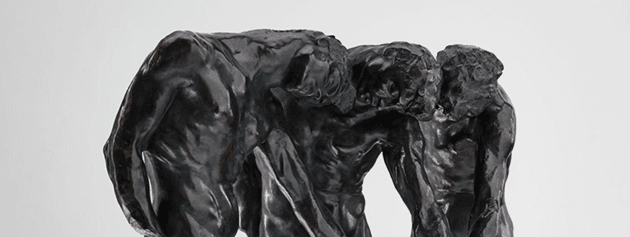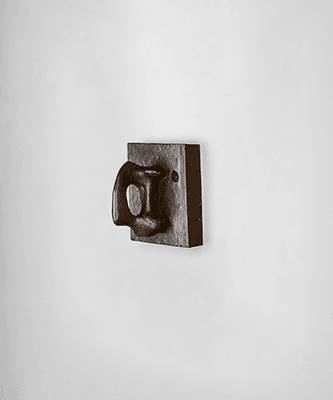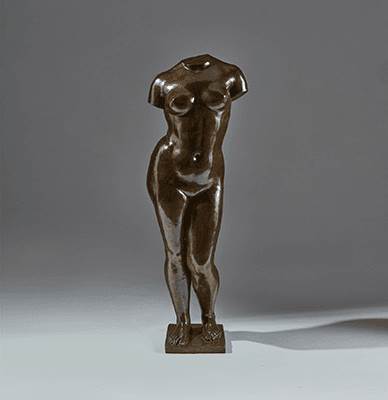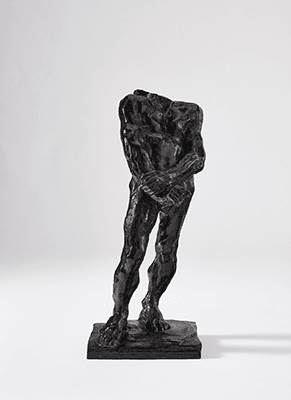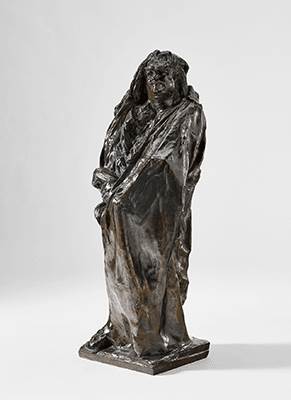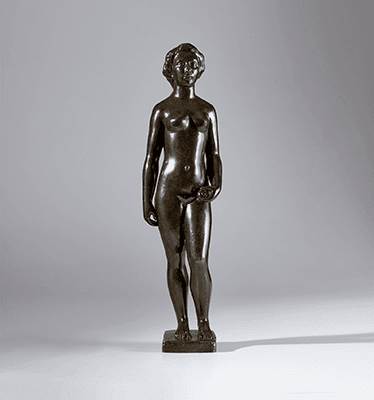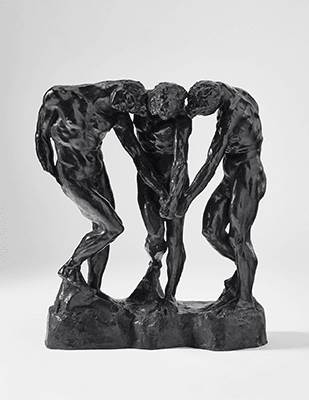20th Century & Contemporary Art Day Sale - Morning Session
New York Auction 18 November 2021
101
Max Ernst
Delicate Arch (Zion National Park)
Estimate $70,000 - 90,000
Sold for $604,800
Create your first list.
Select an existing list or create a new list to share and manage lots you follow.
102
Max Ernst
Paysage extraordinaire
Estimate $18,000 - 25,000
Sold for $22,680
Create your first list.
Select an existing list or create a new list to share and manage lots you follow.
103
Max Ernst
Déchets d'oeuvres
Estimate $18,000 - 25,000
Sold for $17,640
Create your first list.
Select an existing list or create a new list to share and manage lots you follow.
104
Max Ernst
Ohne Titel (Fantôme angélique)
Estimate $35,000 - 45,000
Sold for $40,320
Create your first list.
Select an existing list or create a new list to share and manage lots you follow.
105
Max Ernst
Strange Hallucination!
Estimate $7,000 - 9,000
Sold for $6,930
Create your first list.
Select an existing list or create a new list to share and manage lots you follow.
106
Max Ernst
Forêt
Estimate $7,000 - 9,000
Sold for $9,450
Create your first list.
Select an existing list or create a new list to share and manage lots you follow.
107
Leonor Fini
Girl with Shells
Estimate $12,000 - 18,000
Sold for $63,000
Create your first list.
Select an existing list or create a new list to share and manage lots you follow.
108
Leonor Fini
Untitled
Estimate $5,000 - 7,000
Sold for $16,380
Create your first list.
Select an existing list or create a new list to share and manage lots you follow.
109
Max Ernst
Ohne Titel
Estimate $15,000 - 20,000
Sold for $15,120
Create your first list.
Select an existing list or create a new list to share and manage lots you follow.
110
Max Ernst
Hawaï
Estimate $7,000 - 9,000
Sold for $11,340
Create your first list.
Select an existing list or create a new list to share and manage lots you follow.
111
Milton Avery
Green Sea
Estimate $50,000 - 70,000
Sold for $81,900
Create your first list.
Select an existing list or create a new list to share and manage lots you follow.
112
Milton Avery
Sea and Stars
Estimate $200,000 - 400,000
Sold for $352,800
Create your first list.
Select an existing list or create a new list to share and manage lots you follow.
113
Alex Katz
Black Ada and Island
Estimate $150,000 - 200,000
Sold for $365,400
Create your first list.
Select an existing list or create a new list to share and manage lots you follow.
114
Jo Baer
Untitled
Estimate $150,000 - 200,000
Sold for $189,000
Create your first list.
Select an existing list or create a new list to share and manage lots you follow.
115
Anne Truitt
Spring Dryad
Estimate $300,000 - 400,000
Sold for $567,000
Create your first list.
Select an existing list or create a new list to share and manage lots you follow.
116
Louise Bourgeois
Eye
Estimate $200,000 - 300,000
Sold for $529,200
Create your first list.
Select an existing list or create a new list to share and manage lots you follow.
117
Louise Nevelson
Dawn's Landscape I
Estimate $250,000 - 350,000
Sold for $277,200
Create your first list.
Select an existing list or create a new list to share and manage lots you follow.
118
Sturtevant
Johns White Target (First Study)
Estimate $200,000 - 300,000
Sold for $655,200
Create your first list.
Select an existing list or create a new list to share and manage lots you follow.
119
Jamie Wyeth
Excursion Boats, Monhegan
Estimate $250,000 - 450,000
Sold for $277,200
Create your first list.
Select an existing list or create a new list to share and manage lots you follow.
120
Milton Avery
Big Bouquet
Estimate $30,000 - 50,000
Sold for $30,240
Create your first list.
Select an existing list or create a new list to share and manage lots you follow.
121
Alex Katz
Ada in Front of Black Brook
Estimate $180,000 - 250,000
Sold for $378,000
Create your first list.
Select an existing list or create a new list to share and manage lots you follow.
122
Julio González
Personnage allongé II
Estimate $120,000 - 180,000
Sold for $201,600
Create your first list.
Select an existing list or create a new list to share and manage lots you follow.
123
Joan Miró
Figure
Estimate $150,000 - 250,000
Create your first list.
Select an existing list or create a new list to share and manage lots you follow.
124
This lot is no longer available.
125
Auguste Rodin
Balzac, étude de nu type F dite aussi 'étude en athlète'
Estimate $80,000 - 120,000
Sold for $75,600
Create your first list.
Select an existing list or create a new list to share and manage lots you follow.
126
Auguste Rodin
Balzac, étude drapée avec capuchon et un jabot de dentelle
Estimate $250,000 - 350,000
Create your first list.
Select an existing list or create a new list to share and manage lots you follow.
127
Auguste Rodin
Trois ombres, Taille de la Porte dite aussi 'Moyen Modèle'—variante
Estimate $600,000 - 800,000
Create your first list.
Select an existing list or create a new list to share and manage lots you follow.
128
Aristide Maillol
Torse de l'Eté
Estimate $300,000 - 500,000
Create your first list.
Select an existing list or create a new list to share and manage lots you follow.
129
Aristide Maillol
Petite Flore nue
Estimate $100,000 - 150,000
Sold for $75,600
Create your first list.
Select an existing list or create a new list to share and manage lots you follow.
130
Henry Moore
Square Head Relief
Estimate $20,000 - 30,000
Sold for $81,900
Create your first list.
Select an existing list or create a new list to share and manage lots you follow.
131
Bruce Nauman
Untitled (DRAIN 1/DRAIN 2)
Estimate $80,000 - 120,000
Sold for $100,800
Create your first list.
Select an existing list or create a new list to share and manage lots you follow.
132
Frank Stella
Jarmolince III
Estimate $600,000 - 800,000
Sold for $828,600
Create your first list.
Select an existing list or create a new list to share and manage lots you follow.
133
Robert Mangold
Four Triangles Within a Square
Estimate $250,000 - 350,000
Sold for $327,600
Create your first list.
Select an existing list or create a new list to share and manage lots you follow.
134
Bernar Venet
221.5° Arc x 15
Estimate $400,000 - 600,000
Sold for $877,000
Create your first list.
Select an existing list or create a new list to share and manage lots you follow.
135
Sir Anthony Caro, O.M, R.A.
Sea Shanty
Estimate $200,000 - 300,000
Sold for $252,000
Create your first list.
Select an existing list or create a new list to share and manage lots you follow.
136
Sir Anthony Caro, O.M, R.A.
Ballade
Estimate $40,000 - 60,000
Sold for $75,600
Create your first list.
Select an existing list or create a new list to share and manage lots you follow.
137
Claes Oldenburg
Typewriter Eraser
Estimate $300,000 - 500,000
Create your first list.
Select an existing list or create a new list to share and manage lots you follow.
138
This lot is no longer available.
139
Robert Indiana
LOVE (Blue Faces Red Sides)
Estimate $400,000 - 600,000
Sold for $567,000
Create your first list.
Select an existing list or create a new list to share and manage lots you follow.
140
Hans Hofmann
Red Flight
Estimate $400,000 - 600,000
Sold for $352,800
Create your first list.
Select an existing list or create a new list to share and manage lots you follow.
141
Jean Dubuffet
Site Avec 3 Personnages
Estimate $150,000 - 250,000
Sold for $201,600
Create your first list.
Select an existing list or create a new list to share and manage lots you follow.
142
This lot is no longer available.
143
Joel Shapiro
Untitled
Estimate $120,000 - 180,000
Create your first list.
Select an existing list or create a new list to share and manage lots you follow.
144
Joel Shapiro
Untitled
Estimate $60,000 - 80,000
Sold for $47,880
Create your first list.
Select an existing list or create a new list to share and manage lots you follow.
145
Carl Andre
Fault
Estimate $20,000 - 30,000
Sold for $63,000
Create your first list.
Select an existing list or create a new list to share and manage lots you follow.
146
Brice Marden
Letter of Gratitude #8
Estimate $100,000 - 150,000
Create your first list.
Select an existing list or create a new list to share and manage lots you follow.
147
Brice Marden
Study for Cold Mountain 3
Estimate $20,000 - 30,000
Sold for $15,120
Create your first list.
Select an existing list or create a new list to share and manage lots you follow.
148
David Smith
Untitled
Estimate $15,000 - 20,000
Sold for $17,640
Create your first list.
Select an existing list or create a new list to share and manage lots you follow.
149
Robert Rauschenberg
The Red Virgin
Estimate $100,000 - 150,000
Create your first list.
Select an existing list or create a new list to share and manage lots you follow.
150
Cy Twombly
Untitled
Estimate $400,000 - 600,000
Sold for $529,200
Create your first list.
Select an existing list or create a new list to share and manage lots you follow.
151
Willem de Kooning
Three Women
Estimate $80,000 - 120,000
Sold for $63,000
Create your first list.
Select an existing list or create a new list to share and manage lots you follow.
152
Richard Pettibone
Andy Warhol 'Two Elvis' 1964
Estimate $60,000 - 80,000
Sold for $107,100
Create your first list.
Select an existing list or create a new list to share and manage lots you follow.
153
Richard Pettibone
Andy Warhol 'Marilyn Monroe' 1964
Estimate $40,000 - 60,000
Sold for $138,600
Create your first list.
Select an existing list or create a new list to share and manage lots you follow.
154
Richard Pettibone
Andy Warhol 'Two Flowers' 1964
Estimate $30,000 - 40,000
Sold for $47,880
Create your first list.
Select an existing list or create a new list to share and manage lots you follow.
155
Andy Warhol
Carlo de Benedetti (Positive)
Estimate $100,000 - 150,000
Sold for $100,000
Create your first list.
Select an existing list or create a new list to share and manage lots you follow.
156
Andy Warhol
Mr. Demos
Estimate $100,000 - 150,000
Sold for $100,000
Create your first list.
Select an existing list or create a new list to share and manage lots you follow.
157
Ed Paschke
Icon-Ero
Estimate $70,000 - 90,000
Sold for $81,900
Create your first list.
Select an existing list or create a new list to share and manage lots you follow.
158
Roger Brown
Flying in Formation
Estimate $60,000 - 80,000
Sold for $69,300
Create your first list.
Select an existing list or create a new list to share and manage lots you follow.
159
Martin Wong
WACO Studio Loft
Estimate $30,000 - 40,000
Sold for $63,000
Create your first list.
Select an existing list or create a new list to share and manage lots you follow.
160
Richard Artschwager
Building Wrecks
Estimate $40,000 - 60,000
Sold for $81,900
Create your first list.
Select an existing list or create a new list to share and manage lots you follow.
161
Gerhard Richter
Abstraktes Bild (872-6)
Estimate $350,000 - 450,000
Sold for $327,600
Create your first list.
Select an existing list or create a new list to share and manage lots you follow.
162
Joe Goode
Untitled (Torn Cloud Triptych)
Estimate $30,000 - 50,000
Sold for $138,600
Create your first list.
Select an existing list or create a new list to share and manage lots you follow.
163
Malcolm Morley
Approaching Valhalla
Estimate $80,000 - 120,000
Sold for $94,500
Create your first list.
Select an existing list or create a new list to share and manage lots you follow.
164
Lawrence Weiner
Preparatory Drawings For Gyroscopically Speaking
Estimate $40,000 - 60,000
Sold for $81,900
Create your first list.
Select an existing list or create a new list to share and manage lots you follow.
165
Lee Lozano
Two works: (i–ii) No title
Estimate $15,000 - 20,000
Sold for $20,160
Create your first list.
Select an existing list or create a new list to share and manage lots you follow.
166
Lee Lozano
No title
Estimate $12,000 - 18,000
Sold for $20,160
Create your first list.
Select an existing list or create a new list to share and manage lots you follow.
167
Susan Rothenberg
Olive
Estimate $40,000 - 60,000
Sold for $107,100
Create your first list.
Select an existing list or create a new list to share and manage lots you follow.
168
Susan Rothenberg
Untitled
Estimate $30,000 - 40,000
Sold for $50,400
Create your first list.
Select an existing list or create a new list to share and manage lots you follow.
169
Susan Rothenberg
Untitled
Estimate $40,000 - 60,000
Sold for $88,200
Create your first list.
Select an existing list or create a new list to share and manage lots you follow.
170
Christo
The Umbrella Project for Japan and Western U.S.A.
Estimate $50,000 - 70,000
Sold for $138,600
Create your first list.
Select an existing list or create a new list to share and manage lots you follow.
171
Christo
Wrapped Reichstag (Project for Berlin)
Estimate $70,000 - 100,000
Sold for $157,500
Create your first list.
Select an existing list or create a new list to share and manage lots you follow.
172
Lawrence Carroll
Untitled (Grey Sleeping Painting)
Estimate $15,000 - 20,000
Sold for $32,760
Create your first list.
Select an existing list or create a new list to share and manage lots you follow.
173
Louise Nevelson
Landscape
Estimate $20,000 - 30,000
Sold for $35,280
Create your first list.
Select an existing list or create a new list to share and manage lots you follow.
174
Richard Tuttle
Lonesome Cowboy Styrofoam #2
Estimate $10,000 - 15,000
Create your first list.
Select an existing list or create a new list to share and manage lots you follow.
175
Robert Mangold
Yellow/White Zone
Estimate $15,000 - 20,000
Sold for $18,900
Create your first list.
Select an existing list or create a new list to share and manage lots you follow.
176
Sam Francis
Untitled Mandalas
Estimate $40,000 - 60,000
Sold for $37,800
Create your first list.
Select an existing list or create a new list to share and manage lots you follow.
177
Robert Rauschenberg
Crane
Estimate $120,000 - 180,000
Sold for $138,600
Create your first list.
Select an existing list or create a new list to share and manage lots you follow.
178
Sam Francis
Untitled
Estimate $40,000 - 60,000
Sold for $37,800
Create your first list.
Select an existing list or create a new list to share and manage lots you follow.
179
Karel Appel
Tête volante
Estimate $40,000 - 50,000
Sold for $63,000
Create your first list.
Select an existing list or create a new list to share and manage lots you follow.
180
Kazuo Shiraga
Jikkai-zu Gaki Chikushokai
Estimate $100,000 - 150,000
Sold for $126,000
Create your first list.
Select an existing list or create a new list to share and manage lots you follow.
181
Louise Fishman
Angle of Repose
Estimate $8,000 - 12,000
Sold for $28,980
Create your first list.
Select an existing list or create a new list to share and manage lots you follow.
182
Al Held
Padua I
Estimate $30,000 - 50,000
Sold for $40,320
Create your first list.
Select an existing list or create a new list to share and manage lots you follow.
183
Ron Gorchov
Comedy
Estimate $40,000 - 60,000
Sold for $189,000
Create your first list.
Select an existing list or create a new list to share and manage lots you follow.
184
Frank Stella
The Prop of the Nation
Estimate $50,000 - 70,000
Sold for $75,600
Create your first list.
Select an existing list or create a new list to share and manage lots you follow.
185
Pablo Atchugarry
Armonía Vitale
Estimate $30,000 - 40,000
Sold for $56,700
Create your first list.
Select an existing list or create a new list to share and manage lots you follow.
186
Agustín Cárdenas
Totem
Estimate $70,000 - 100,000
Sold for $138,600
Create your first list.
Select an existing list or create a new list to share and manage lots you follow.
187
Alicia Penalba
Oiseau lunaire
Estimate $30,000 - 40,000
Sold for $73,080
Create your first list.
Select an existing list or create a new list to share and manage lots you follow.
188
Sergio Camargo
Sin título
Estimate $70,000 - 90,000
Sold for $138,600
Create your first list.
Select an existing list or create a new list to share and manage lots you follow.
189
Paolo Scheggi
Inter-Ena-Cubo
Estimate $50,000 - 70,000
Sold for $63,000
Create your first list.
Select an existing list or create a new list to share and manage lots you follow.
190
Yayoi Kusama
Bronze Shoes
Estimate $15,000 - 20,000
Sold for $107,100
Create your first list.
Select an existing list or create a new list to share and manage lots you follow.
191
Nam June Paik
Enlightenment Compressed
Estimate $40,000 - 60,000
Sold for $107,100
Create your first list.
Select an existing list or create a new list to share and manage lots you follow.
192
Kim Tschang-Yeul
Bacchus
Estimate $40,000 - 60,000
Sold for $52,920
Create your first list.
Select an existing list or create a new list to share and manage lots you follow.
193
Frank Gehry
Fish Lamp
Estimate $100,000 - 150,000
Sold for $239,400
Create your first list.
Select an existing list or create a new list to share and manage lots you follow.
194
Arnaldo Pomodoro
Pillars for Amaliehaven IV
Estimate $20,000 - 30,000
Sold for $63,000
Create your first list.
Select an existing list or create a new list to share and manage lots you follow.
195
Lynn Chadwick, R.A.
Sitting Figure I
Estimate $15,000 - 20,000
Sold for $37,800
Create your first list.
Select an existing list or create a new list to share and manage lots you follow.
196
Lynn Chadwick, R.A.
Sitting Figure II
Estimate $15,000 - 20,000
Sold for $52,920
Create your first list.
Select an existing list or create a new list to share and manage lots you follow.
197
Marino Marini
Pomona III
Estimate $30,000 - 50,000
Sold for $32,760
Create your first list.
Select an existing list or create a new list to share and manage lots you follow.
198
Francisco Zúñiga
Soledad Sentada
Estimate $150,000 - 200,000
Create your first list.
Select an existing list or create a new list to share and manage lots you follow.
199
Richmond Barthé
Stevedore
Estimate $60,000 - 80,000
Sold for $69,300
Create your first list.
Select an existing list or create a new list to share and manage lots you follow.
200
Pavel Tchelitchew
Study for a cover of the theater program for the Ballet Russes
Estimate $10,000 - 15,000
Sold for $31,500
Create your first list.
Select an existing list or create a new list to share and manage lots you follow.
201
Gustav Klimt
Porträt einer Frau
Estimate $100,000 - 150,000
Sold for $113,400
Create your first list.
Select an existing list or create a new list to share and manage lots you follow.
202
Jean-Baptiste-Camille Corot
Vallée solitaire
Estimate $40,000 - 60,000
Sold for $63,000
Create your first list.
Select an existing list or create a new list to share and manage lots you follow.
203
Cândido Portinari
Retrato de Magu Leão
Estimate $20,000 - 30,000
Sold for $30,240
Create your first list.
Select an existing list or create a new list to share and manage lots you follow.
204
Fernando Botero
Naranjas
Estimate $180,000 - 250,000
Sold for $283,500
Create your first list.
Select an existing list or create a new list to share and manage lots you follow.
205
Fernando Botero
Nature Morte
Estimate $30,000 - 40,000
Sold for $40,320
Create your first list.
Select an existing list or create a new list to share and manage lots you follow.
206
Fernando Botero
Dancers
Estimate $30,000 - 40,000
Sold for $52,920
Create your first list.
Select an existing list or create a new list to share and manage lots you follow.
207
Tom Wesselmann
Study for Bedroom Painting #1
Estimate $50,000 - 70,000
Sold for $75,600
Create your first list.
Select an existing list or create a new list to share and manage lots you follow.
208
Roy Lichtenstein
Drawing for Inaugural Print
Estimate $30,000 - 50,000
Sold for $35,280
Create your first list.
Select an existing list or create a new list to share and manage lots you follow.
209
Robert Motherwell
Untitled (Wine Label Collage)
Estimate $25,000 - 35,000
Sold for $31,500
Create your first list.
Select an existing list or create a new list to share and manage lots you follow.
210
Franz West
Untitled (Dancing Elephants)
Estimate $10,000 - 15,000
Sold for $30,240
Create your first list.
Select an existing list or create a new list to share and manage lots you follow.
211
Anselm Kiefer
Das Goldene Kalb
Estimate $60,000 - 80,000
Sold for $69,300
Create your first list.
Select an existing list or create a new list to share and manage lots you follow.
212
John Kacere
Adrian
Estimate $15,000 - 25,000
Sold for $18,900
Create your first list.
Select an existing list or create a new list to share and manage lots you follow.
213
Bob Stanley
Trees #5
Estimate $6,000 - 9,000
Sold for $3,780
Create your first list.
Select an existing list or create a new list to share and manage lots you follow.
214
Tom of Finland
Eleven works: (i-xi) Untitled (Motorcycle Series)
Estimate $180,000 - 250,000
Sold for $189,000
Create your first list.
Select an existing list or create a new list to share and manage lots you follow.
215
Kazuya Sakai
Pintura No. 26
Estimate $10,000 - 15,000
Sold for $16,380
Create your first list.
Select an existing list or create a new list to share and manage lots you follow.
216
Fernando de Szyszlo
Punchao
Estimate $30,000 - 40,000
Sold for $30,240
Create your first list.
Select an existing list or create a new list to share and manage lots you follow.
217
Francisco Toledo
Sapo y Chapulin
Estimate $80,000 - 120,000
Sold for $81,900
Create your first list.
Select an existing list or create a new list to share and manage lots you follow.
218
This lot is no longer available.
219
Carmelo Arden Quin
Roi III
Estimate $20,000 - 30,000
Create your first list.
Select an existing list or create a new list to share and manage lots you follow.
220
Alexander Calder
Soleil Noir
Estimate $50,000 - 70,000
Sold for $189,000
Create your first list.
Select an existing list or create a new list to share and manage lots you follow.
221
Alexander Calder
Les Masques
Estimate $30,000 - 50,000
Sold for $302,400
Create your first list.
Select an existing list or create a new list to share and manage lots you follow.
222
Kenny Scharf
Staticontrol
Estimate $70,000 - 100,000
Sold for $277,200
Create your first list.
Select an existing list or create a new list to share and manage lots you follow.
223
Kenny Scharf
Box Life
Estimate $25,000 - 35,000
Sold for $126,000
Create your first list.
Select an existing list or create a new list to share and manage lots you follow.
